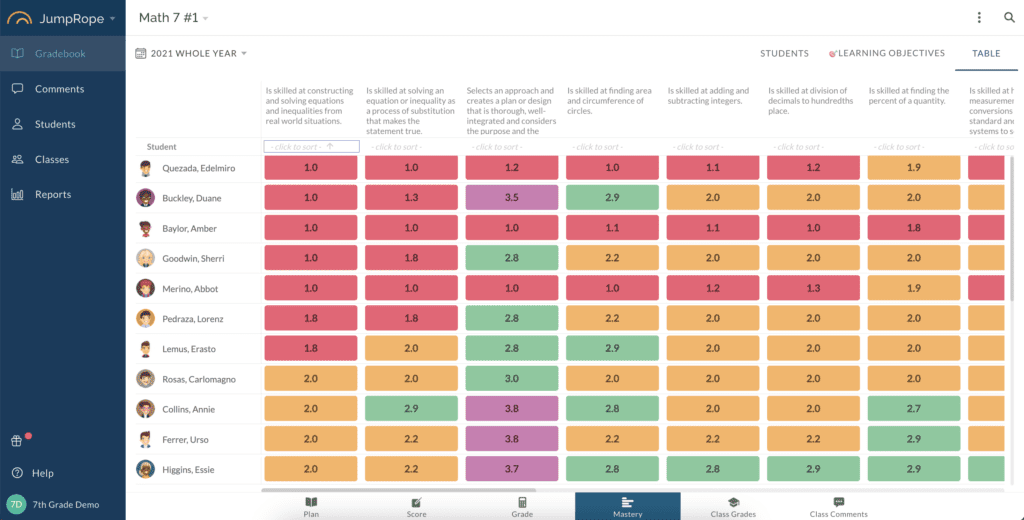Increasingly in my travels, I’m running into teachers, schools, and districts who are working hard to implement student learning objectives (SLOs) as part of their teaching strategy as well as their teacher evaluation system. Stemming from the educator effectiveness law and this guide from the feds, SLOs are being adopted across the country as one way to measure individual teachers’ contributions to their students’ learning growth. As I’ve learned more about the implementation of SLOs in states like Ohio, Maryland, Maine, and Georgia, I’ve been doing a lot of thinking about how they relate to standards- and proficiency-based grading systems.
At its core the SLO workflow of selecting an objective based on available student achievement data and documenting progress fits very nicely into JumpRope’s mastery-based assessment and reporting system.
At its core the SLO workflow of selecting an objective based on available student achievement data and documenting progress fits very nicely into JumpRope’s mastery-based assessment and reporting system. In fact, the SLO process as it plays out in many of our partner schools and districts is a perfect fit with their grading system because it informs the selection of SLOs (based on historical achievement data) and documents student growth “for free” since the teacher is already entering mastery data into JumpRope for the purpose of giving feedback to students and informing their instructional practices. In other words, JumpRope essentially already supports the entire workflow of creating and documenting SLOs with even more detail than required by the federal government or most states.
Of course, there are some pieces of the SLO workflow that still occur outside of the gradebook such as the collection of student work artifacts, the development of instructional strategies to meet the objective(s), and the process of reflecting on and submitting the data to the state. I’ve also run into certain implementations of SLOs that would require a separate analysis system because the SLOs are based on a standardized assessment delivered at the beginning and end of a course, rather than historical achievement data from students in the same content area.
In hopes of helping educators who are currently implementing both SLOs and JumpRope in their classrooms (as well as those who are seeking tools to help them do so), I’d like to propose a workflow within JumpRope’s features to select and document progress on SLOs. Many of you are likely already doing something very similar!
Step 1: Select your SLO(s)
Depending on the requirements in your school and your teaching position, you may be required to select a specific number of SLOs that cover a certain number of courses or students. Regardless of the details, you’ll want to begin by looking at existing standards-based student achievement data for your cohort of students. Viewing the Table view in Mastery allows you to sort and see students’ current level of performance.

If your school has been using JumpRope for more than one term or year, there is a built in report to show you historical achievement for your students within a specific content area (for example, if you teach 8th grade math, you can see how your current students did, per learning goal, in their 7th grade math class).
From this report, you can select one or more learning objectives for which you see both the need and potential for growth and use the language to design an SLO. You can even make an intelligent decision about how many students are likely to meet the goal after completing your course if your local SLO requirements involve choosing the number of students you’re hoping will meet the objective.
Step 2: Do nothing different!
The best part about selecting an SLO from the data available in JumpRope is that the work you’re already doing to enter mastery data and give students regular feedback more than qualifies as evidence of learning for the SLO requirements. You may wish to review local requirements in order to ensure that the frequency and type of assessments (i.e. formative vs. summative, projects vs. tests) are met within your body of assessment. You may also wish to collect samples of student work outside of JumpRope’s system if you’re required to submit these. Otherwise, keep on grading!
Step 3: Review your results
Using a report very similar to that used to initially select your SLOs, you can review students’ progress during your course. Simply load a report by student, by course, or across all of your students, and you can analyze the results using various metrics, including:
-
- The overall level of mastery on the SLO or sub-targets related to the SLO at the middle and end of the year;
- The level of growth shown by the students on the related targets;
- Various other calculations can be viewed side-by-side without affecting the students’ “grades,” including the Power Law, Max Value, Most Recent, Decaying Average, and Simple Average of the mastery scores (more info in this document);
- You can even segment students by various demographic data if this level of analysis is part of your state’s requirements.
There you have it. While the details of how SLOs are used vary from state to state, the bottom line is that they amount to a standards-based analysis of student progress in their time with you as their teacher. While I’ll stay clear of the political aspects of teacher evaluation systems (for now), I’m excited to see that a metric as robust and fair as student mastery and growth per learning objective is being used as one measure of teacher effectiveness. I hope that JumpRope can both save you time and help you be more effective determining SLOs, measuring progress throughout the year, and analyzing results.




